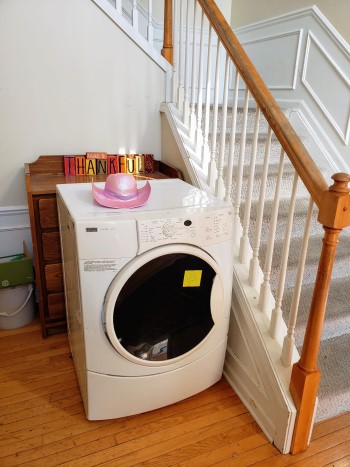Hi friends,
A quick pic for you, since I thought you might get a laugh about the slightly different look to our entry way.

No, that’s not the same dryer from last week.
We finally installed the new one, spent the weekend catching up on laundry . . . and have a broken dryer in the entry way now – LOL!
At least the 6-year-old’s pink cowboy hat is there to dress it up a bit. 😀
______________________
I’ve got a water preparedness tip for you today. Clean water is crucial in the aftermath of a disaster.
First, a story . . . because I love stories:
My parents lived near the epicenter of the 1989 Loma Prieta earthquake that killed a lot of people and left my family with no power, water or gas for weeks. (I was away at college)
They used a broken-handled shovel to dig a latrine in a corner of their back yard. There was a small stream in the area that was quickly swarmed by thirsty people and they thankfully had some food storage because of long-standing council to be prepared from church leaders.
So, what did my mom consider most important after that traumatic experience?
Well, years later, she flew out to visit me for the birth of my fourth child. One day, the power in our whole area went out suddenly. She burst into action, ordering the kids to go find as many empty 5-gallon buckets as possible. Minutes later, she’d organized an assembly line on the lawn of grandma and the kids washing out buckets, filling clean ones and then putting on tight lids. When the lids ran out, she used aluminum foil.
About an hour later, when we had a row of 15 buckets or so, full of water, she relaxed, let out a breath, and then said, “All right. Now we can relax.”
Moral of the story?
Water. Water. Water.
From someone who lived through an earthquake with no utilities or help for weeks, my mother considered clean water to be the most precious resource.
So, my first water tip is advice on where to find clean water than many people may not have considered.
1. The toilet tanks in your house or business contain about 2 – 4 gallons of water each.
Yes, the tanks contain clean water as long as they’ve been maintained. Though, if you get desperate, you can use the bowl water if you have a way to purify it. So in a disaster, don’t let anyone flush and lose those gallons of valuable water.
2. Your water heater can contain between 40 and over 100 gallons.
There is usually a valve on the bottom and then some way to allow air in the top so the water can drain. Take the time now to check out how yours works, and you’ll have another valuable source of drinkable water in an emergency.
If you have good preparedness tips about clean water in an emergency, be sure to send them to me! I’ll make sure to include them in future editions.
Stay safe out there.
______________________
Misty’s Writing Update:
It’s time to buckle down and write. We wrote the first couple of chapters for Searching for Victory, Book #6 over the weekend, but this was our first full week of writing.
We generally start with an outline of what needs to happen in each chapter, but the fun and magical part happens during the actual writing, when the characters come alive and fun twists and turns pop up unexpectedly.
I think Steph and I have found a great method of combining both planning and spontaneous creativity in the way we write together. It keeps it fun and interesting enough that we still enjoy writing.
Though there are still plenty of tired, burned-out days, as in any endeavor, but we plow through because we’re both committed to what we’re doing.
For tips on how I handle procrastination – check out last week’s NL if you missed it. 😀
Happy reading out there!
— Misty 🙂

Recent Comments